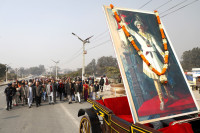Opinion
A stitch in time
As the recent monsoon rainfall-induced floods overran large swathes of the Nepal Tarai and parts of Bangladesh and India, including Bihar, disturbing images of the havoc they wrought were flashed across news channels and information platforms.
Ujol Sherchan
As the recent monsoon rainfall-induced floods overran large swathes of the Nepal Tarai and parts of Bangladesh and India, including Bihar, disturbing images of the havoc they wrought were flashed across news channels and information platforms.
Amidst these stories of disaster and destruction, there were, however, some that told of how small interventions and actions saved the day for many people in these flood-prone areas.
One such story comes from Bihar’s Shrikhandi Village, bordering Mahottari District of Nepal.
As Sanjay Pandey, Director of Yuganter, an organsation based in Patna, put it: “By the time the flood waters reached Shrikhandi in Sitamarhi District of Bihar on 12 August 2017, the women, men and children of the village had evacuated to safe places, taking with them what possessions they could, including livestock.”
An important question arises here: How were the inhabitants of Shrikhandi able to make a safe evacuation before more floodwaters arrived, while elsewhere, hundreds of people, from village after village, were caught off guard?
The short answer lies in community-based flood early warning systems (CBFEWSs) set up along the transboundary Ratu River in the Koshi Basin.
Saving lives
The flood early warning systems in Lalghad and Sarpallo on the Nepali side of the border were set up by the International Centre for Integrated Mountain Development (ICIMOD) in partnership with Nepal’s Department of Hydrology and Meteorology under the Community-Based Flood and Glacial Lake Outburst Risk Reduction Project. The same systems across the border in Bihar, including in Bhittamore, were set up in agreement with the Department of Disaster Management, Government of Bihar and in partnership with Yuganter.
CBFEWS is a system of Information and Communications Technology (ICT) and trained human personnel put in place in a flash-flood-prone area to forewarn nearby as well as downstream communities of impending floods, to ensure that they have adequate lead-time—the time between the warning and the arrival of the flood—to prepare and respond.
It is also a proven system for which ICIMOD and its partners, Aranyak and Sustainable Eco Engineering, were awarded UNFCCC’s Momentum for Change: 2014 Lighthouse Activity Award at the UN Climate Summit in Lima, Peru for demonstrating impact on the ground during the 2013 Assam Floods in India.
On that fateful night of August 12, 2017, Mahendra Bikram Karki, the caretaker of the early warning instrument installed on the bank of the Ratu River in Lalgadh, heard the receiver unit in his house beep its insistent warning, signifying that the water level on the Ratu River had risen above the danger level. The siren outside his house went off, alerting the locals nearby of the impending floods.
Karki wasted no time in doing what he had been trained to do: warn the communities of Lalgadh and nearby villages so that they could move to safe zones in the dead of night. He also notified his counterparts downstream by using his mobile: Rajkumar Mahato in Sarpallo, Mahottari, and Ranjeet Kumar across the border in Bhittamore, Bihar, among others.
Kumar, in turn, disseminated the flood alert to Shrikhandi and six adjoining villages downstream, giving them an unprecedented seven to eight-hour lead-time for flood preparedness and response. He also alerted the local administration of the Sursand Block and Sithamarhi District. Upon learning of the impending floods, the people of those villages evacuated to safe places, taking what they could with them. Many of the evacuees already knew what to do in such a situation, as they had participated in mock drills in the past.
The timely dissemination of flood early warnings from the upstream part of the Ratu River in Nepal to downstream vulnerable villages, including those across the border, made all the difference.
Future preparation
As the people affected by the August 2017 floods struggle to achieve some semblance of normalcy, with or without outside assistance, who is to say that they will not experience a repeat of the same next year or the year after that? According to the Fifth Assessment Report of the Intergovernmental Panel on Climate Change (IPCC), the frequency and severity of extreme-weather events such as this August’s sudden heavy downpours are likely to increase in the future due to rising temperatures.
Therefore, the country needs to brace itself for a future of flash floods.
One way to do that is to perhaps further upscale successful models of CBEFWS to the flash-flood-prone tributaries, minor rivers, and flashy ephemeral rivers across Nepal that pose grave dangers to downstream communities (but are not covered by CBEFWS). And to do it in a way that involves all relevant multi-stakeholders, builds on past experience, and addresses existing challenges and issues going forward.
- Sherchan is Knowledge Management and Communications Officer at International Centre for Integrated Mountain Development (ICIMOD)




 4.68°C Kathmandu
4.68°C Kathmandu











